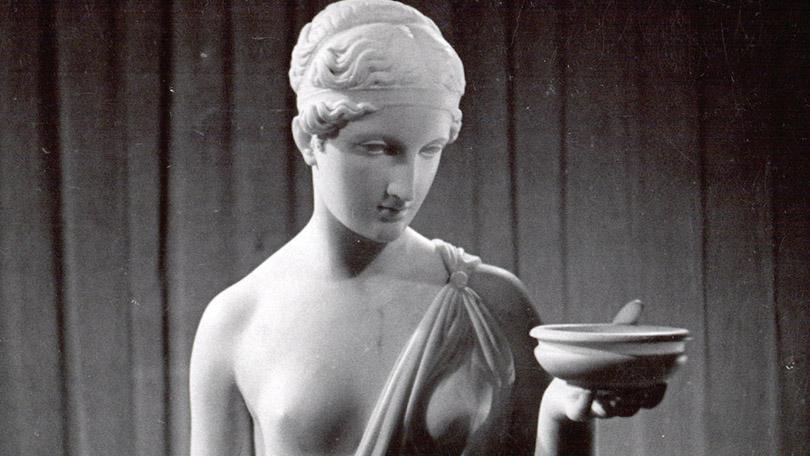Michelangelo by the German director Curt Oertel opened in Denmark in January 1941, sparking a so-called "so ein ding müssen wir auch haben" discussion about making a similar film about the Danish neo-classical sculptor Bertel Thorvaldsen (1770-1844). Everyone agreed that such a film should be done right or not at all. However, there was less agreement about defining the concept of "right." The architect Steen Eiler Rasmussen wrote an opinion piece 09.01.1941 in the Politiken newspaper:
Now, if one wants to do a Thorvaldsen film, one should strive to make its form as clean and controlled as Thorvaldsen’s own works. Control means restraint and resourcefully utilising the technical effects. Heaven save us from carnival and costume gags!
The debate fizzled out again, and it was not until summer 1947 that Dreyer was assigned to write a script for a film about Thorvaldsen’s art. Ib Koch-Olsen wrote museum keeper Sigurd Schultz to bring this to his attention, asking him "to lend Mr Dreyer help and support when in his work on this he applies to you." Dreyer could use the help. He wanted to move some of the statues and place them on turntables, so that they could revolve in the light and acquire a more lively visual expression. The staff at Thorvaldsen’s Museum was obviously wary of exposing the statues to such risk.
Dreyer made the film with Preben Frank, with whom he had worked on The Danish Village Church and The Storstrøm Bridge, but he had problems getting Frank to put in a full workday. Dreyer wrote several letters to Koch-Olsen complaining about this, even going so far as to accuse Frank of truancy and asking Koch-Olsen to keep "his [Frank’s] nose to the grindstone," since they had a job to finish. As it turned out, there was a very understandable reason for Frank’s lagging performance, he was sick with cancer. In Koch-Olsen’s opinion – and Dreyer’s, too, actually – some of the shots were not particularly good and Dreyer suggested having Frank do them on his own.
(...) for I think he would put in an insane effort, if only to prove to you that he does not need my help.
Frank did the shots under protest, and only because Dansk Kulturfilm (that is, Koch-Olsen) insisted.
In the original draft for the opening credits, Dreyer was credited as writer and director, while Frank was credited only as director of photography, which thought was unfair. He wrote Koch-Olsen on 8 October 1948, pointing out that he did originally not want to be onboard Thorvaldsen. Immediately before filming Thorvaldsen, Dreyer and Frank had shot The Storstrøm Bridge. That shoot dragged out from "8-10 days" to "over a month," and on that film Frank had merely been "Photographer for a Well-Known Director."
Frank only agreed to do Thorvaldsen because Koch-Olsen said he would be co-directing with Dreyer, and so he was surprised to discover that he was credited only for the photography. Koch-Olsen made a note in the margin of the letter that, indeed, he had mentioned the possibility, but ultimately it was up to Dreyer. According to Frank, there was a clear-cut agreement with The Danish Village Church that he would be directing, while "Dreyer called himself assistant director and did not want to be named in the opening credits." Frank thought he was being pushed aside because Dansk Kulturfilm was better served by crediting a well-known name as director. Frank made it clear that he would rather withdraw completely than let himself be pushed aside again.
Frank declined an offer to be credited as director of The Storstrøm Bridge, as he was not looking for a consolation prize, but simply wanted to be credited for the work he claimed to have done on Thorvaldsen.
The opening credits ended up looking like this:
THORVALDSEN
Filmed by
CARL TH. DREYER
and
PREBEN FRANK
in collaboration with
SIGURD SCHULTZ
Preben Frank died on 21 February 1949.
